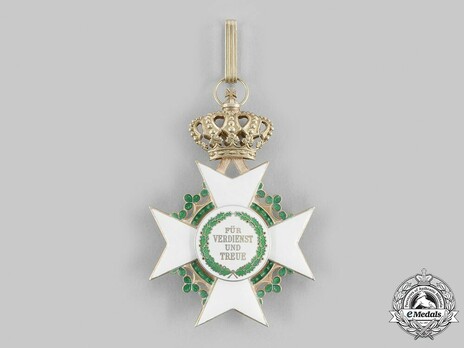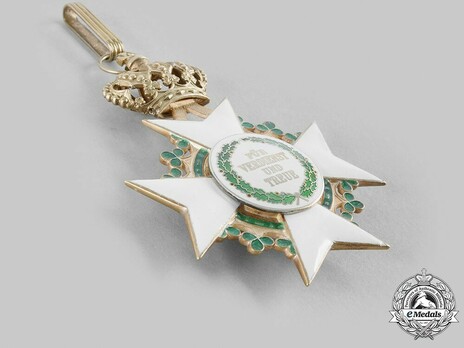Order of Merit, Type II, Civil Division, Grand Cross
SKU: 01.SXK.0106.101.01
Estimated market value:









Estimated market value:
Attributes
Physical Description
A George’s cross with Maltese-type arms, constructed of gold and enamel. On top of the 12 o’clock arm sits a cut-out crown, attached by two curved links. The arms are enamelled in white with narrow golden edges. In between the arms is a circumferential rue wreath in green enamel with golden edges. The obverse centre medallion is enamelled in white and features the Saxon coat of arms in multi-coloured enamel and with a golden crown on top, with the circumferential inscription ‘FRIED. AUG. K. V. SACHSEN D. 7. JUN. 1815’ (‘Friedrich August King of Saxony on June 7, 1815’) in black letters. The medallion ring is golden and smooth. The reverse is similar, except that the centre medallion features the black inscription ‘FÜR VERDIENST UND TREUE’ (‘for merit and loyalty’) inside a painted oak leaf wreath in green enamel. On a loop for suspension, on a white ribbon with green side stripes.
History
The Order of Merit was founded by King Friedrich August after his release from imprisonment in 1815. The order was conferred upon citizens of Saxony and foreign citizens in recognition of merit and virtue within distinguished civil services. The allowance of foreigners into the order was unofficially added in 1828, and was accompanied by a specific inscription.
At the conception, the order consisted of a Grand Cross, Commander, and Knight. A civil medal was indirectly counted as the 4th class. The council for the order consisted of four committees and one order secretary, all of whom were appointed by the king. It was the order council who proposed new members.
The order was originally called the "Order of Civil Merit", but the name was changed in 1849 to the "Order of Merit". On June 7, 1849, the Commander was divided into two classes. The I Class Commander is worn with a four-pointed breast star, increasing the total number of classes to five. Shortly after, in 1858, the small cross was renamed the “Cross of Honour”.
In 1866, the order grades were also awarded with crossed swords to recognise recipients for military merit and service. On December 9, 1870, King Johann decreed that if the order was awarded to persons who had already received the same class without war decoration, the swords were placed below the award's ring. When a higher class without swords was awarded to a holder of a lower class with war decoration, swords were placed above the award's ring on the higher class.
In 1876, the statutes were amended once again. The Knight’s Cross was split into the I Class and II Class Knight. Owners of the Cross of Honour could exchange their decoration for the II Class Knight. The Cross of Merit was introduced as the 6th class of the order, and could also be awarded with swords. The owners of the Golden Merit Medal could exchange it for a Cross of Merit at this time.
Type I decorations are identified by the features stated above. They do not have a surmounting crown, and the central medallions are painted. For residents, the inscription translates to “FOR LOYALTY AND MERIT” while decorations to foreigners state “FOR MERIT”.
Type II decorations are identified as those awarded from 1891 until 1918. In 1891, the order saw the addition of the royal golden crown to the Grand Cross and the Commander. The latter decoration was further split into the first and second class as well. Medallions were also applied instead of painted.
In 1905, the China expedition gave cause to the conferral of more decorations. While the statutes prescribed the order be awarded with swords, in the majority of cases however, the higher decoration without swords was awarded. Examples of swords on ring are quite uncommon.
The obverse presents the name and title of the founder and the date of creation “Friedrich August K.(önig) V. (on) Saxony D. 7 June 1815” and the reverse inscription translates to “For Merit and Loyalty”.
In March 1910, the jeweller G. A. Scharffenberg was commissioned to make simplified versions of the decorations, to lower the overall production cost. This includes gold plating and one-piece embossed medallions. The following month, the king accepted the altered manufacturing method, which consisted of the centre shield being made of one piece for all classes. Decorations prior to 1911 that are marked 'S' refer to silver used as material, not Scharffenberg.
A total of 30 Grand Crosses were awarded, 17 in gold and 13 in silver gilt. From 1905 onwards, Grand Crosses were only made in gold-plated silver. After 1910, the medallion was simplified.
The Grand Cross with applied Geneva Cross was awarded to Prince Johann George in 1915. It was awarded in recognition of his associations of the Red Cross in the kingdom of Saxony, and extensive and beneficial activities, especially when visiting the hospitals on both the front lines of war and at home. The Cross and Star awarded to him were in the Saxon Army Musuem, but have been lost since 1945.

Versions
$8,200 USD
Gold/Enamelled
Obv: FRIED. AUG. K. V. SACHSEN D. 7. JUN. 1815 Rev: FÜR VERDIENST UND TREUE
88x62mm
17 were awarded. Specimens in gold were awarded up to 1905.
$3,500 USD
Silver gilt/Enamelled
Obv: FRIED. AUG. K. V. SACHSEN D. 7. JUN. 1815 Rev: FÜR VERDIENST UND TREUE
87x61mm
13 were awarded. Specimens in silver gilt were awarded post-1915.
$20,000 USD
Silver gilt/Enamelled
Obv: FRIED. AUG. KV. SACHSEN D. 7. JUN. 1815 Rev: FÜR VERDIENST UND TREUE
87x60.5mm
Only one was awarded, to Prince Johann George in 1915. Its whereabouts are unknown.


Comments
Sign in to comment and reply.


Scroll Top